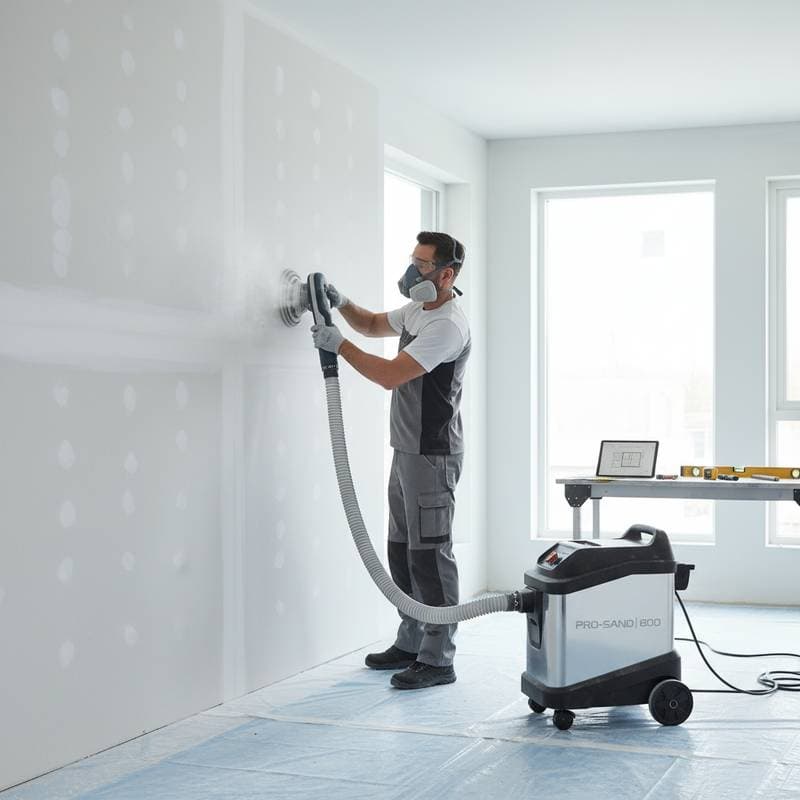Why Professional Sanding Preparation Costs $800 and More
Homeowners often pause when a painting estimate lists $800 or higher for sanding and surface preparation. This essential phase establishes the base for a durable paint application. Without thorough preparation, paint may peel, bubble, or fade prematurely, leading to costly repairs. Grasping the components of this process reveals its value in safeguarding your property.
Components of Professional Sanding Preparation
Surface preparation extends beyond basic sanding. Experts first examine walls for underlying issues, then address them methodically to promote strong paint adhesion. The full procedure encompasses several key actions.
- Initial inspection: Professionals assess surface integrity, detect old paint layers, and pinpoint defects like cracks or moisture damage.
- Protection measures: Teams cover floors with drop cloths, tape off trim and fixtures, and seal air vents to contain debris.
- Power sanding: High-quality orbital or belt sanders remove imperfections while integrated vacuums capture dust at the source.
- Manual finishing: Workers use fine-grit sandpaper by hand for edges, corners, and intricate moldings to achieve seamless results.
- Debris elimination: Thorough vacuuming follows, supplemented by tack cloths that pick up residual particles without redistributing them.
- Repair work: Technicians apply joint compound to holes and fissures, sand smooth once dry, and treat any loose sections.
These steps demand precision and patience. A well-prepared surface allows primer and paint to adhere uniformly, minimizing defects over time.
Breaking Down Project Expenses
Typical Price Ranges
Costs vary based on project scope and complexity.
- Basic preparation: $600 to $850 covers small spaces with light touch-ups.
- Standard preparation: $800 to $1,400 applies to several rooms requiring moderate fixes.
- Advanced preparation: $1,500 to $2,500 handles expansive areas, significant wear, or delicate materials like antique plaster.
Standard Inclusions
Estimates typically cover:
- Skilled labor for sanding, repairs, and final cleaning.
- Rental or ownership of industrial tools and their upkeep.
- Supplies such as plastic sheeting, painter's tape, and protective gear for furnishings.
- A comprehensive check to confirm surface readiness prior to painting.
Additional Charges
Certain elements incur extra fees:
- Major structural fixes exceeding simple patches.
- Specialized handling for lead-based paints, including containment barriers.
- Full drywall replacement or remediation of water-affected areas.
- Application of textured or custom surface treatments.
Influences on Total Expenses
Several variables determine the final figure.
| Factor | Impact on Cost | Specific Examples |
|---|---|---|
| Existing Surface State | Higher with deterioration | Flaking layers, fractures, damp spots |
| Substrate Material | Elevated for sensitive types | Vintage plaster, ornate woodwork, unique coatings |
| Access Challenges | Extends work hours | Vaulted ceilings, winding stairs, confined spaces |
| Dust Management | Demands advanced gear | HEPA vacuums, plastic enclosures |
Reasons for Professional Pricing
Experienced teams invest in tools and knowledge that exceed typical homeowner capabilities. Industrial sanders prevent gouges, while extraction units maintain air quality. Workers wear respirators and follow protocols to avoid health risks from airborne particles. Such measures ensure a flawless base without compromising safety.
Beyond equipment, professionals provide insurance against accidents, required certifications, and guarantees on workmanship. Consumables like abrasive discs, fillers, and sealants accumulate expenses on bigger jobs. These factors collectively justify the premium, delivering results that endure.
Timeline and Effort Involved
Sanding preparation requires dedicated time, often spanning hours or days per section. Factors shaping duration include:
- Overall area and room count.
- Degradation level of current finishes.
- Extent of necessary restorations.
- Curing periods for applied compounds.
Haste in this phase invites problems like patchy coverage or early degradation. Investing effort here streamlines subsequent painting and averts rework.
Comparing DIY and Expert Approaches
Homeowners might handle minor sanding for spot fixes, but comprehensive projects benefit from professional intervention.
Key DIY Aspects
Attempting it yourself involves:
- Essential protective equipment, including N95 masks and eye shields.
- Managing pervasive dust that infiltrates HVAC systems and fabrics.
- Selecting progressive sandpaper grits, from coarse to ultra-fine.
- The danger of excessive abrasion that etches or weakens substrates.
Benefits of Hiring Experts
Professionals deliver:
- Consistent smoothness for optimal bonding.
- Sophisticated filtration to minimize mess.
- Accurate correction of flaws without further harm.
- Compliance with health, safety, and eco-regulations.
This expertise translates to a superior, longer-lasting outcome.
Collaborating Effectively with Contractors
To secure quality work:
- Request an itemized quote distinguishing preparation from application fees.
- Verify credentials, including bonds and permits for surface work.
- Review client testimonials or images of prior prep demonstrations.
- Discuss schedules, containment strategies, and post-job restoration explicitly.
Preparing for Your Painting Initiative
Start with a home walkthrough to note trouble spots. Budget for preparation as a core component, recognizing its role in longevity. Select contractors who emphasize detail in their proposals. This foresight yields walls that withstand daily use and retain vibrancy.
Common Questions on Sanding Preparation
Why does preparation inflate painting quotes?
It demands intensive manual effort, premium machinery, and meticulous cleanup. Protective setups and incidental fixes further contribute. Expertise ensures these elements align for enduring quality.
How much time does expert preparation require?
A single room often needs one to two full days, varying with flaw severity. Expansive or compromised zones may demand additional sessions.
Does self-sanding reduce expenses?
Initial savings appear attractive, yet errors often necessitate professional corrections at higher cost. Experts provide reliable uniformity that sustains the paint layer.
What questions should you pose to contractors about preparation?
Inquire on filtration methods, patching techniques, and pre-paint evaluations. Detailed responses indicate thoroughness and reliability.
Can unexpected fees arise in preparation?
Yes, discoveries like extensive deterioration, hazardous materials, or infiltration issues trigger add-ons. Preemptive assessments mitigate such risks.
How do you care for prepared and painted surfaces?
Wipe gently with mild solutions, steer clear of abrasive cleaners, and mend minor damages promptly. Routine upkeep extends the investment's lifespan.



